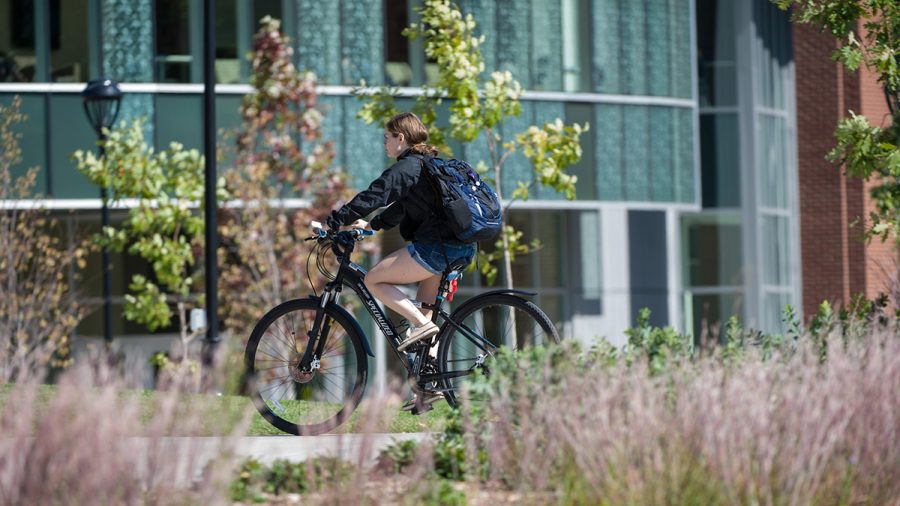Eau Claire drivers, bicyclists need to create a safer environment for bike-commuters
Many students rely on their bikes as their main form of transportation and face inadequate streets as they pedal through some areas of Eau Claire
Photo by SUBMITTED
The city of Eau Claire encompasses 9 bike trails, according to the city’s website, but conditions for bike-commuters in the city still need improvement.
My favorite part of my morning is the commute from my apartment to campus. As I pedal my bike through downtown Eau Claire, the rising sun flirts with its reflection on windows. Leaves on golden trees wave hello to me in the morning wind. Around me, Eau Claire gently stretches its arms, greeting a new day.
But my bliss is interrupted when I have to grip both my brakes and come to a screeching halt in the intersection between Barstow Street and Gibson Street to let a car turn out in front of me.
Eau Claire’s bustling downtown is full of blind spots created by parked cars. There is not a bike lane. Cars carefully edge past me, a little too close for comfort.
I am forced to remember that although section 10.08.110 of Eau Claire’s Code of Ordinance requires me to ride my bike on the street, I will not receive the same traffic respect as a car.
Eau Claire needs a safer bicycle culture because so many of its residents — especially students — depend on bicycle transportation.
Owning a bike is cheap, so a lot of students rely on their bikes as their main form of transportation. There are about 2,000 bike racks on the UW-Eau Claire campus for bike-commuters, according to the university website.
Despite the popularity of cycling, the dangers and difficulties of this form of transportation persist.
Although Eau Claire is home to miles of pedestrian paths, getting to a grocery store like Aldi’s or Festival Foods requires biking on some roads that do not have painted edges, according to a map of roadway edge lines in Eau Claire.
Interactions with cars on these busy roads pose a threat for cyclists. 60 percent of adult bicycle crashes occur because of a car driver’s error, according to the Wisconsin Department of Transportation.
This presents a socioeconomic problem. The absence of safe routes is unfair to those who can only afford to bike.
“I think that there’s a general sense of transportation as a justice issue,” Jeremy Gragert, a transportation activist and UW-Eau Claire alumni told the Chippewa Herald. “There are people who aren’t old enough to drive. Also people of any income, college students and younger people try to avoid having to buy a car because it’s very expensive.”
Fortunately, the Eau Claire City Council passed a resolution in Nov. 2010 to adopt the Bicycle and Pedestrian Plan, a piece of legislation with a goal to make walking and biking in the city “desirable and accessible,” according to the plan’s objective.
The included initiatives should be completed in ‘the next 20 or more years,” says the plan’s objective.
While bicyclists wait for the plan to come to fruition, they should become well-versed in bicycle safety. Hand turn signals, reflective gear and helmets are necessities. Wearing a helmet can “prevent more than 85 percent of head injuries when crashes do happen,” according to the Wisconsin Department of Transportation.
Respect is a two-way street, especially when it comes to bicycle safety. If cyclists are responsible, drivers will be as well, and the Eau Claire community can keep peddling its way towards a bike-friendly future.

Neupert is a fourth-year journalism student at UW-Eau Claire. She is the executive producer of Engage Eau Claire on Blugold Radio Sunday. In her spare time, Neupert's working on becoming a crossword puzzle expert.

